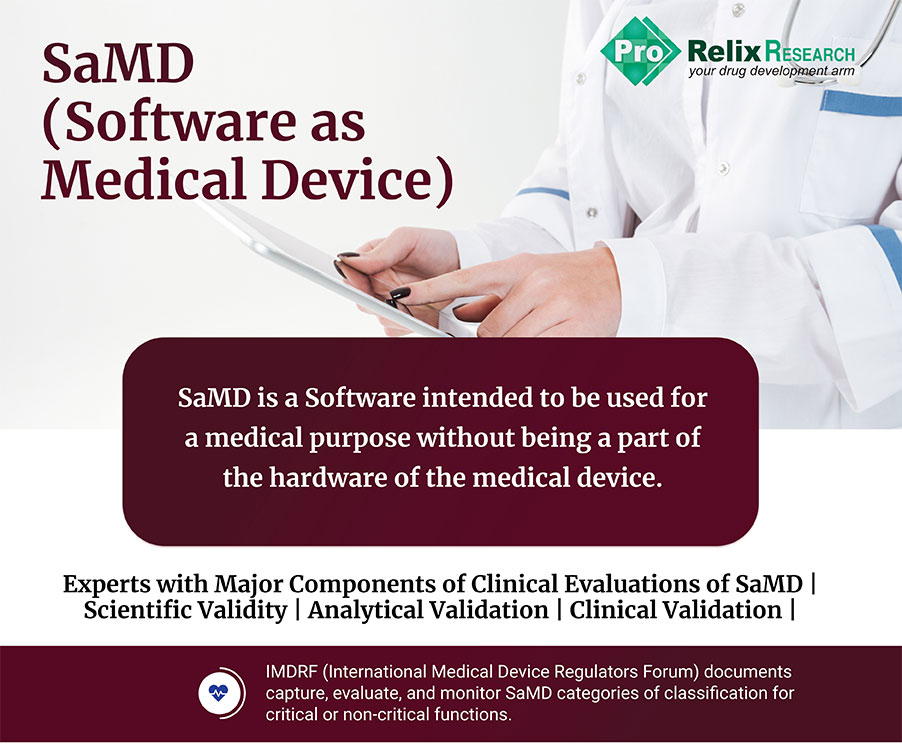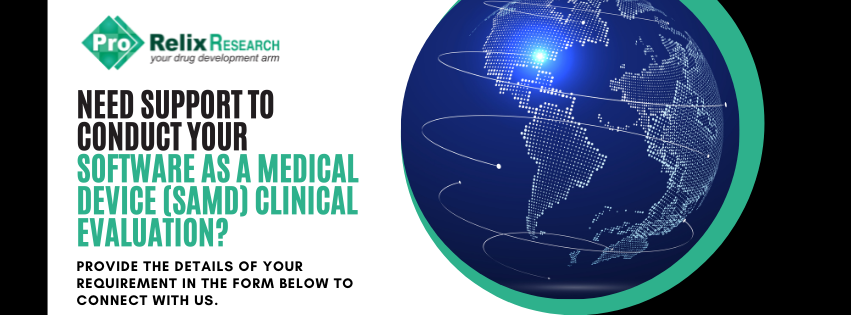The use of software to inform healthcare decisions is ubiquitous and is being utilized by patients, clinicians, and healthcare providers. Proper understanding, planning, and design of SaMD is essential for approval. ProRelix Research provides customized solutions and helps you adapt to the challenges associated with SaMDs to allow for a smooth transition from concept to healthcare decision making.
The rising prevalence of internet of things (IoT) and developments in cloud computing, artificial intelligence, and smartphones has facilitated innovations in medical devices. This has led to the use of software for medical and non-medical purposes (financial, administrative purposes) in healthcare. The International Medical Device Regulators Forum (IMDRF) defines Software as Medical Device (SaMD) as “software intended to be used for one or more medical purposes that perform these purposes without being part of a hardware medical device.” SaMD provides means for mitigation, detection, diagnosis, and monitoring of physiological status, health, illnesses, or congenital deformities. Some examples of SaMD include software that allows MRI or medical images to be viewed on mobile devices, image processing to detect cancer, BMI and body fat calculators, and heart rate monitors, and software that regulates pacemakers.
The International Medical Device Regulators Forum (IMDRF) developed the SaMD working group in 2013 with the aim of uniting all frameworks and principles on SaMD thus enabling innovation and protection of patient safety. The IMDRF working group is chaired by the Food and Drug Administration (FDA) and has released guidance documents related to SaMD on key definitions (IMDRF/SaMD WG/N10), risk categorization (IMDRF/SaMD WG/N12), quality management system (IMDRF/SaMD WG/N23), and clinical evaluation (IMDRF/SaMD WG/N41). These documents were developed to harmonize terminology and requirements that are necessary to overcome the challenges and regulatory gaps associated with SaMD for all stakeholders such as manufacturers and regulatory agencies.
SaMD’s can be divided into four categories depending upon the significance of the information provided by the SaMD to the healthcare decision (treatment, diagnosis, drive or inform clinical management) and the state of the healthcare situation or condition (critical, serious, non-serious). Category I SaMD has the lowest impact whereas Category IV has the highest impact and thus the degree of clinical evaluation particularly safety assessment varies depending upon the category. Another IMDRF guidance documents focuses on three key principles of quality management system (QMS) for SaMD which include leadership and organizational support, lifecycle support processes (product planning, risk management, document and record control, configuration and management control, and measurement, analysis, and improvement of processes and products), and SaMD realization and use processes.
In addition to these documents, the US FDA has published a guidance on clinical evaluation of SaMD using principles and recommendations issued by IMDRF. Clinical evaluation is defined as a set of ongoing activities conducted in the assessment and analysis of a SaMD’s clinical safety, effectiveness, and performance as intended by the manufacturer in the SaMD’s definition statement. This document highlights that clinical evaluation should be an ongoing process as part of the QMS and the importance of independent review in special cases. Since the output of software is increasingly being used to inform healthcare decisions it is necessary for the level of scientific rigor and breadth of the clinical evaluation to be in proportion to risk and impact of the SaMD and its role in the target condition thereby providing assurance of safety and effectiveness through reliable and predictable output data.

The clinical evaluation process encompasses three main activities which include
- Valid clinical association or scientific validity: degree of association between the SaMD’s output (concept, conclusion, measurements) and targeted clinical condition or healthcare situation
- Analytical/technical validation: ability of the SaMD to process input data correctly and reliably and accurately, reliably, and precisely generate the technical output. This is usually confirmed during the verification and validation phase of software development by the manufacturer using a QMS.
- Clinical validation: proof that the SaMD’s output data achieves the product’s intended purpose in terms of clinical care which maybe diagnosis, treatment, prediction of risk or response. Clinical validity is determined and evaluated by the manufacturer both during the pre-market and post-market phases.

Evidence generation is an important component of all clinical evaluation activities and therefore it is important to choose a partner that can help you along the way. Our team at ProRelix Research collaborates with you to understand your SaMD needs and provides the following services:
- Collection and collation of existing evidence from literature searches, original clinical research, and professional society guidelines, clinical guidelines in peer-reviewed journals
- Collection of patient data or extraction from databases for analytical validation
- Design of clinical plans and development of clinical study reports
- Continuous monitoring and collection of real-world evidence (RWE)
- Data collection from post-marketing studies
- Development of quality documents such as Standard Operating Procedures (SOPs)
Need Support to Conduct your Software as a Medical Device Clinical Evaluation?
We’d be delighted to assist you in conducting your Software as a Medical Device Clinical Evaluation
Connect with our experienced staff today!!
Provide details of your requirements by clicking on the given link below and our professional team of clinical research experts will get in touch with you right away.




